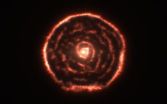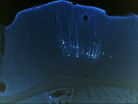(Press-News.org) The well-documented presence of excessive levels of carbon dioxide (CO2) in our atmosphere is causing global temperatures to rise and glaciers and ice caps to melt.
New research, published today, 11 October, in IOP Publishing's Journal of Physics D: Applied Physics, has shown that CO2 molecules may be having a more direct impact on the ice that covers our planet.
Researchers from the Massachusetts Institute for Technology have shown that the material strength and fracture toughness of ice are decreased significantly under increasing concentrations of CO2 molecules, making ice caps and glaciers more vulnerable to cracking and splitting into pieces, as was seen recently when a huge crack in the Pine Island Glacier in Antarctica spawned a glacier the size of Berlin.
Ice caps and glaciers cover seven per cent of the Earth—more than Europe and North America combined—and are responsible for reflecting 80 per cent of the Sun's light rays that enter our atmosphere and maintain the Earth's temperature. They are also a natural carbon sink, capturing a large amount of CO2.
"If ice caps and glaciers were to continue to crack and break into pieces, their surface area that is exposed to air would be significantly increased, which could lead to accelerated melting and much reduced coverage area on the Earth. The consequences of these changes remain to be explored by the experts, but they might contribute to changes of the global climate," said lead author of the study Professor Markus Buehler.
Buehler, along with his student and co-author of the paper, Zhao Qin, used a series of atomistic-level computer simulations to analyse the dynamics of molecules to investigate the role of CO2 molecules in ice fracturing, and found that CO2 exposure causes ice to break more easily.
Notably, the decreased ice strength is not merely caused by material defects induced by CO2 bubbles, but rather by the fact that the strength of hydrogen bonds—the chemical bonds between water molecules in an ice crystal—is decreased under increasing concentrations of CO2. This is because the added CO2 competes with the water molecules connected in the ice crystal.
It was shown that CO2 molecules first adhere to the crack boundary of ice by forming a bond with the hydrogen atoms and then migrate through the ice in a flipping motion along the crack boundary towards the crack tip.
The CO2 molecules accumulate at the crack tip and constantly attack the water molecules by trying to bond to them. This leaves broken bonds behind and increases the brittleness of the ice on a macroscopic scale.
###
Notes to Editors
Contact
1. For further information, a full draft of the journal paper or contact with one of the researchers, contact IOP Press Officer, Michael Bishop:
Tel: 0117 930 1032
E-mail: Michael.bishop@iop.org
Carbon dioxide enhances fragility of ice crystals
2. The published version of the paper 'Carbon dioxide enhances fragility of ice crystals' (Zhao Qin and Markus J Buehler 2012 J. Phys. D: Appl. Phys. 45 445302) will be freely available online from Thursday 11 October.
Journal of Physics D: Applied Physics
3. This weekly journal is concerned with all aspects of applied physics research, from magnetism, plasmas and semiconductors to the structure and properties of matter.
IOP Publishing
4. IOP Publishing provides publications through which leading-edge scientific research is distributed worldwide. IOP Publishing is central to the Institute of Physics (IOP), a not-for-profit society. Any financial surplus earned by IOP Publishing goes to support science through the activities of IOP. Beyond our traditional journals programme, we make high-value scientific information easily accessible through an ever-evolving portfolio of community websites, magazines, conference proceedings and a multitude of electronic services. Focused on making the most of new technologies, we're continually improving our electronic interfaces to make it easier for researchers to find exactly what they need, when they need it, in the format that suits them best. Go to http://ioppublishing.org/.
The Institute of Physics
5. The Institute of Physics is a leading scientific society promoting physics and bringing physicists together for the benefit of all.
It has a worldwide membership of around 40 000 comprising physicists from all sectors, as well as those with an interest in physics. It works to advance physics research, application and education; and engages with policymakers and the public to develop awareness and understanding of physics. Its publishing company, IOP Publishing, is a world leader in professional scientific communications. Go to www.iop.org
Glaciers cracking in the presence of carbon dioxide
2012-10-11
ELSE PRESS RELEASES FROM THIS DATE:
Close call – bad weather drives up phone calls to our nearest and dearest
2012-10-11
Who we call and how long we speak to them changes with the weather, according to new research by experts at Newcastle University.
Analysing the call patterns of 1.3 million mobile phone users, the team found that in 'uncomfortable' weather – such as very hot, humid, wet or cold weather – call length increased but the number of people we made contact with went down.
Apparently "isolating" ourselves during more unpleasant weather, research lead Dr Santi Phithakkitnukoon said the data showed that we were also more likely to contact our close friends and family than our wider ...
Surprising spiral structure spotted by ALMA
2012-10-11
A team using the Atacama Large Millimeter/submillimeter Array (ALMA), the most powerful millimetre/submillimetre telescope in the world, has discovered a surprising spiral structure in the gas around the red giant star R Sculptoris [1][2][3]. This means that there is probably a previously unseen companion star orbiting the star [4]. The astronomers were also surprised to find that far more material than expected had been ejected by the red giant.
"We've seen shells around this kind of star before, but this is the first time we've ever seen a spiral of material coming ...
Singing mice show signs of learning
2012-10-11
DURHAM, N.C. -- Guys who imitate Luciano Pavarotti or Justin Bieber to get the girls aren't alone. Male mice may do a similar trick, matching the pitch of other males' ultrasonic serenades. The mice also have certain brain features, somewhat similar to humans and song-learning birds, which they may use to change their sounds, according to a new study.
"We are claiming that mice have limited versions of the brain and behavior traits for vocal learning that are found in humans for learning speech and in birds for learning song," said Duke neurobiologist Erich Jarvis, who ...
First WGS of multiple pancreatic cancer patients outlined in study by TGen, Mayo and SHC
2012-10-11
PHOENIX, Ariz. — Oct. 10, 2012 — Whole genome sequencing — spelling out all 3 billion letters in the human genome — "is an obvious and powerful method for advancing our understanding of pancreatic cancer," according to a new study from TGen, Mayo Clinic and Scottsdale Healthcare published today.
The Translational Genomics Research Institute (TGen) demonstrated that the use of WGS "represents a compelling solution to obtaining detailed molecular information on tumor biopsies in order to provide guidance for therapeutic selection," concluded the study published by the journal ...
Human neural stem cells study offers new hope for children with fatal brain diseases
2012-10-11
PORTLAND, Ore. – Physician-scientists at Oregon Health & Science University Doernbecher Children's Hospital have demonstrated for the first time that banked human neural stem cells — HuCNS-SCs, a proprietary product of StemCells Inc. — can survive and make functional myelin in mice with severe symptoms of myelin loss. Myelin is the critical fatty insulation, or sheath, surrounding new nerve fibers and is essential for normal brain function.
This is a very important finding in terms of advancing stem cell therapy to patients, the investigators report, because in most ...
The graphene-paved roadmap
2012-10-11
Writing in Nature, Nobel Prize-winner Professor Kostya Novoselov and an international team of authors has produced a 'Graphene Roadmap' which for the first time sets out what the world's thinnest, strongest and most conductive material can truly achieve.
The paper details how graphene, isolated for the first time at The University of Manchester by Professor Novoselov and colleague Professor Andre Geim in 2004, has the potential to revolutionise diverse applications from smartphones and ultrafast broadband to anticancer drugs and computer chips.
One key area is touchscreen ...
NIH–sponsored workshop calls for more detailed reporting in animal studies
2012-10-11
A workshop sponsored by NIH's National Institute of Neurological Disorders and Stroke (NINDS) has produced a set of consensus recommendations to improve the design and reporting of animal studies. By making animal studies easier to replicate and interpret, the workshop recommendations are expected to help funnel promising therapies to patients.
Biomedical research involving animals has led to life-saving drugs for heart disease, cancer, stroke, diabetes, HIV-AIDS, and many other conditions, but positive results from animal studies are sometimes difficult to translate ...
UCSF study shows evidence that transplanted neural stem cells produced myelin
2012-10-11
A Phase I clinical trial led by investigators from the University of California, San Francisco and sponsored by Stem Cells Inc., showed that neural stem cells successfully engrafted into the brains of patients and appear to have produced myelin.
The study, published in the Oct. 10, 2012 issue of Science Translational Medicine, also demonstrated that the neural stem cells were safe in the patients' brains one year post transplant.
The results of the investigation, designed to test safety and preliminary efficacy, are encouraging, said principal investigator David H. ...
Researchers discover how the body uses vitamin B to recognize bacterial infection
2012-10-11
An Australian research team has discovered how specialised immune cells recognise products of vitamin B synthesis that are unique to bacteria and yeast, triggering the body to fight infection.
The finding opens up potential targets to improve treatments or to develop a vaccine for tuberculosis.
The study, jointly led by the University of Melbourne and Monash University and published today in the journal Nature, has revealed for the first time that the highly abundant mucosal associated invariant T cells (MAIT cells), recognise products of vitamin B synthesis from ...
Making crowdsourcing more reliable
2012-10-11
Researchers from the University of Southampton are designing incentives for collection and verification of information to make crowdsourcing more reliable.
Crowdsourcing is a process of outsourcing tasks to the public, rather than to employees or contractors. In recent years, crowdsourcing has provided an unprecedented ability to accomplish tasks that require the involvement of a large number of people, often across wide-spread geographies, expertise, or interests.
The world's largest encyclopaedia, Wikipedia, is an example of a task that can only be achieved through ...



